The automotive world is rapidly shifting towards electrification, but amidst the buzz around fully electric vehicles, hybrid technology continues to shine. For drivers not yet ready to commit to a fully electric lifestyle, or those lacking convenient charging options, hybrid SUVs offer a compelling blend of fuel efficiency and practicality. These gas-electric vehicles, which recharge their batteries through regenerative braking and engine operation, provide significant fuel savings, especially in urban driving scenarios. Building upon technology pioneered decades ago, the latest hybrid SUVs boast advanced powertrains and sophisticated computer controls, making them an excellent stepping stone into automotive electrification. While not emissions-free, they represent a substantial leap towards sustainability, especially for city dwellers. We delve into three compelling 2025 models – the Mazda CX-50 Hybrid, Hyundai Tucson Hybrid, and Lexus UX300h – to determine which reigns supreme in the realm of compact hybrid SUVs.
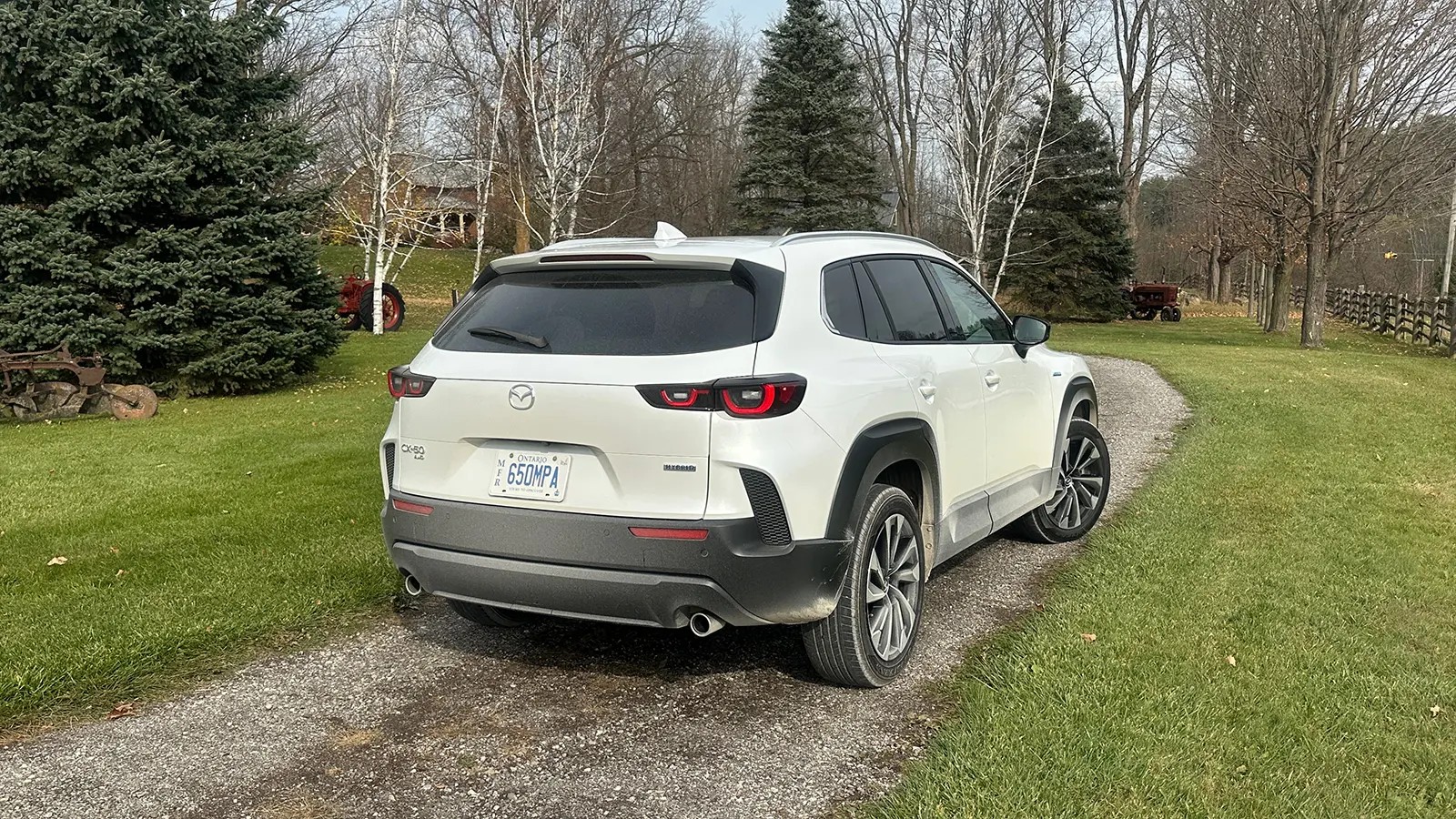 white Mazda CX-50
white Mazda CX-50
Mazda CX-50 Hybrid: Refined Efficiency Takes Center Stage
The Mazda CX-50 has already carved a niche with its rugged styling and adventurous spirit, offering a more outdoorsy alternative to the popular CX-5. For 2025, the CX-50 lineup expands with the introduction of the CX-50 Hybrid, seamlessly integrating Toyota’s renowned hybrid powertrain. This strategic move marries Mazda’s distinctive design and upscale interior with Toyota’s proven hybrid technology, creating a compelling option for efficiency-conscious SUV buyers.
Under the hood, the CX-50 Hybrid mirrors the Toyota RAV4 Hybrid in specifications, featuring a 2.5-liter inline-four engine paired with Toyota’s Hybrid System (THS). This combination delivers 219 horsepower and 163 lb-ft of torque, channeled through a continuously variable transmission (CVT) to three electric motors and a standard electric all-wheel-drive system. While this powertrain offers more horsepower than the base gasoline CX-50, it prioritizes fuel efficiency over outright performance, a departure from Mazda’s traditional “zoom-zoom” ethos. This contrasts with the Hyundai Tucson Hybrid, which offers a sportier N-Line variant catering to enthusiasts.
The Mazda CX-50 Hybrid achieves an EPA-estimated 38 mpg combined, slightly less than the RAV4 Hybrid’s 39 mpg. This minor difference is a testament to the engineering efforts required to integrate the THS into the Mazda platform. Beyond the “Hybrid” badging, subtle styling enhancements distinguish the hybrid model, including extended body cladding and a slightly taller roof to accommodate the traction battery beneath the rear seats without compromising ground clearance (7.6 inches). Despite being longer than many competitors, the CX-50 Hybrid’s cargo space is modestly reduced to 29.2 cubic feet compared to other CX-50 models (31.4 cu-ft), and notably smaller than the RAV4 and Tucson Hybrids (38.7 cu-ft).
Where the CX-50 Hybrid truly excels is in its interior ambiance. Mazda has cultivated a subtly luxurious cabin, particularly in higher trims, laden with premium features. The Premium Plus trim, for example, boasts two-tone leather seats with meticulous camel-colored stitching, echoing throughout the doors and dashboard. A rotary controller, a feature typically found in luxury vehicles, minimizes fingerprints on the touchscreen, complemented by convenient steering wheel controls. Additional buttons near the steering column provide access to memory seat settings, a front-view camera, and parking sensor deactivation.
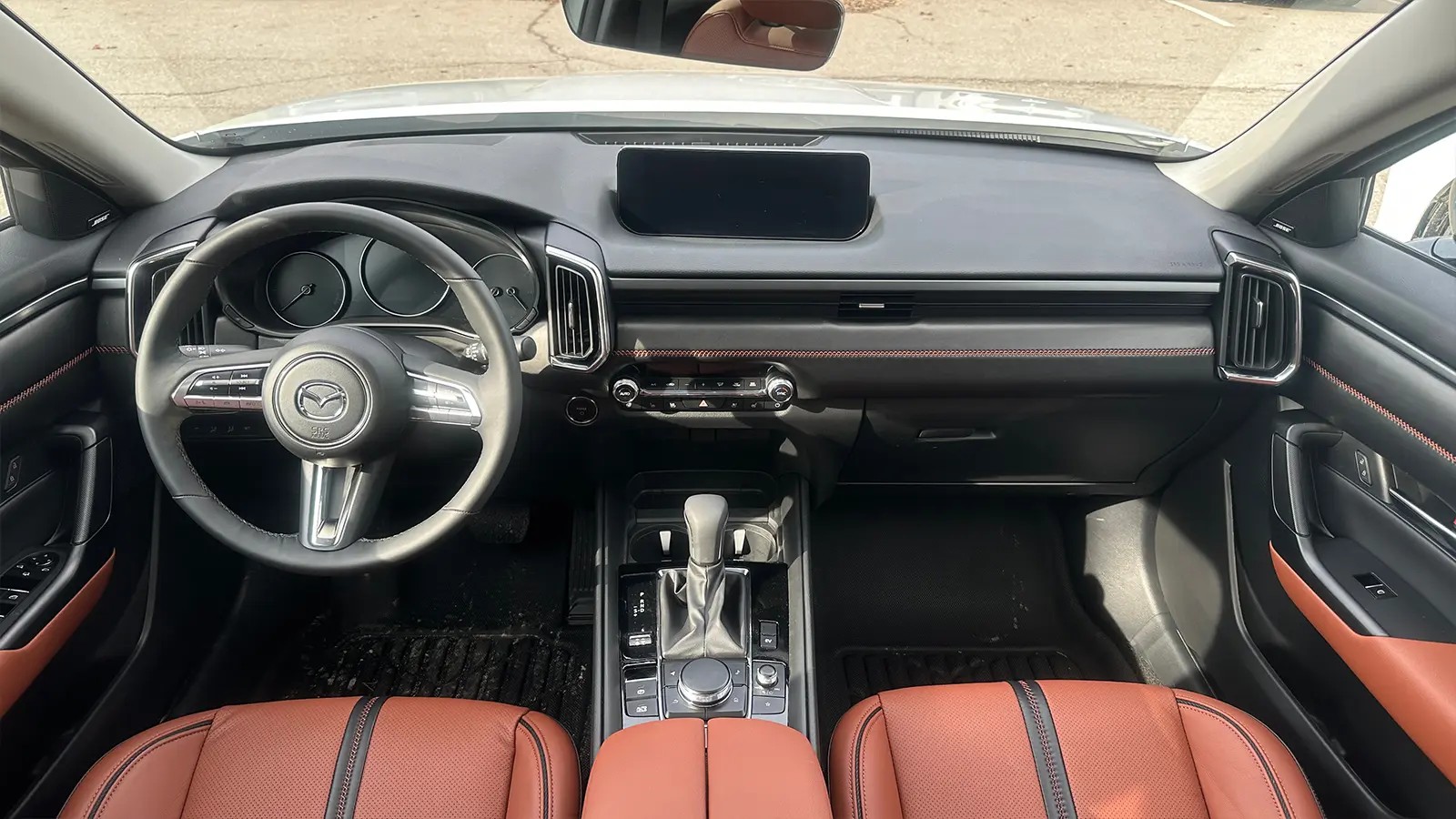 Mazda CX-50 front interior
Mazda CX-50 front interior
While the panoramic sunroof adds an airy feel, the CX-50 Hybrid retains a touch of classic automotive charm. Analog gauges, a lack of extensive LED ambient lighting, and a relatively modest infotainment screen (except when using wireless CarPlay or Android Auto) contribute to a refined, yet slightly traditional, near-luxury experience. The ride quality and cabin quietness further enhance this sense of refinement, feeling more composed than many Toyota hybrids. The CX-50 Hybrid successfully blends Mazda’s sophisticated design language with hybrid efficiency, appealing to buyers seeking a fuel-conscious SUV without sacrificing upscale features.
Priced between $34,000 and $40,000 MSRP, the CX-50 Hybrid occupies the middle ground in the CX-50 lineup, positioned above gasoline models but below the turbocharged variants. This strategic pricing places it in direct competition with the Hyundai Tucson Hybrid, which offers a broader spectrum of hybrid trims and configurations at a similar price point.
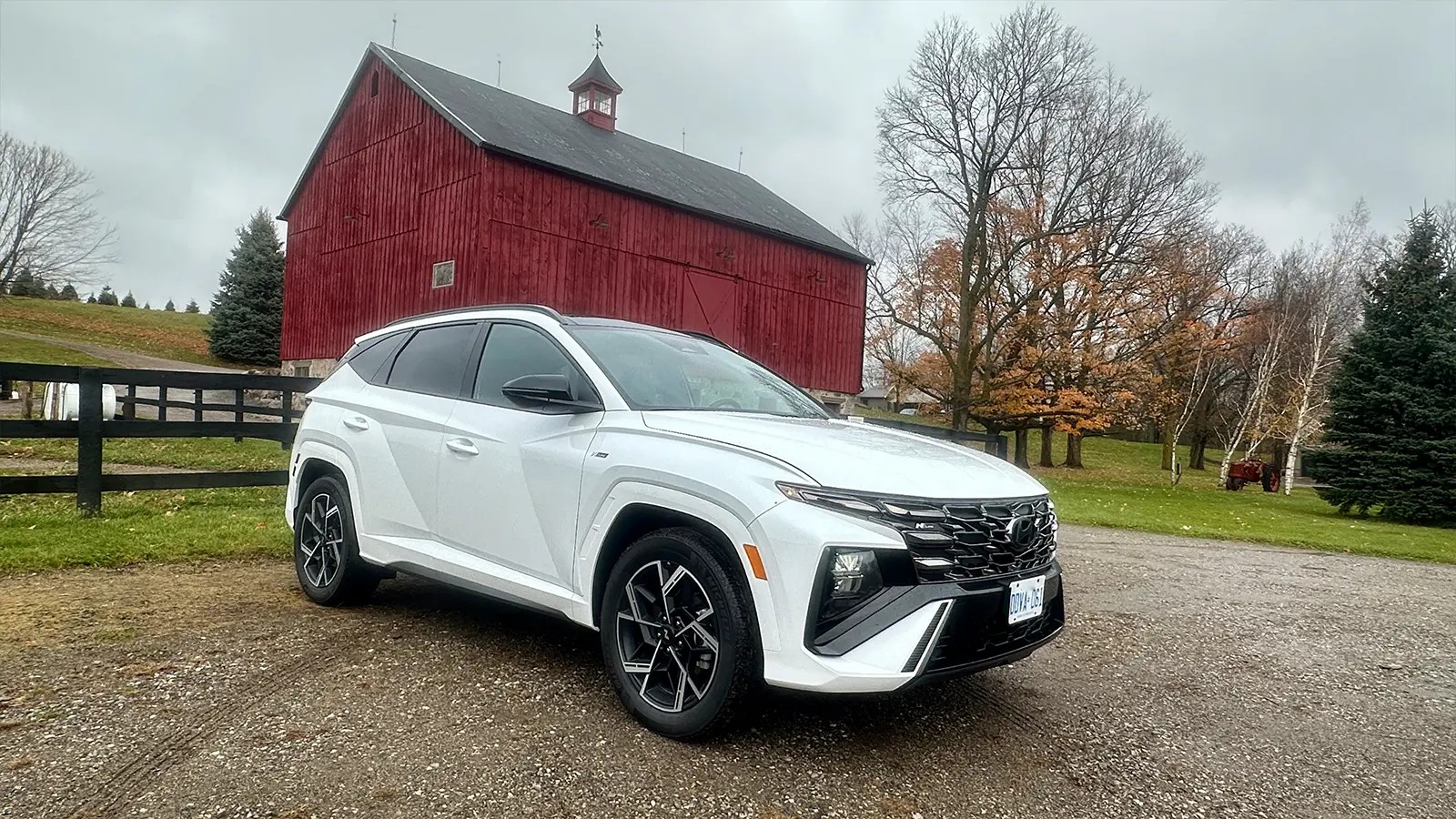 White Hyundai Tucson Hybrid
White Hyundai Tucson Hybrid
Hyundai Tucson Hybrid: A Versatile Hybrid SUV for Every Taste
Hyundai takes a more expansive approach with its Tucson Hybrid, offering a diverse range of trims to cater to varied preferences. Beyond the standard hybrid, the Tucson lineup includes sport-oriented and luxury-focused hybrid trims, as well as a plug-in hybrid (PHEV) variant. The Tucson PHEV is ideal for those prioritizing electric driving, offering 33 miles of all-electric range for daily commutes while retaining the flexibility of a gasoline engine for longer journeys.
The Tucson Hybrid N Line model tested here showcases Hyundai’s sporty take on hybridization. Distinguished by unique 19-inch wheels, black side mirrors, and twin-tip exhaust, the N Line trim projects a dynamic image. For 2025, all Tucson models receive refreshed front fascias with new LED lighting signatures and updated wheel designs, further enhancing the Tucson’s sharp and modern aesthetic, a departure from the softer curves of some competitors.
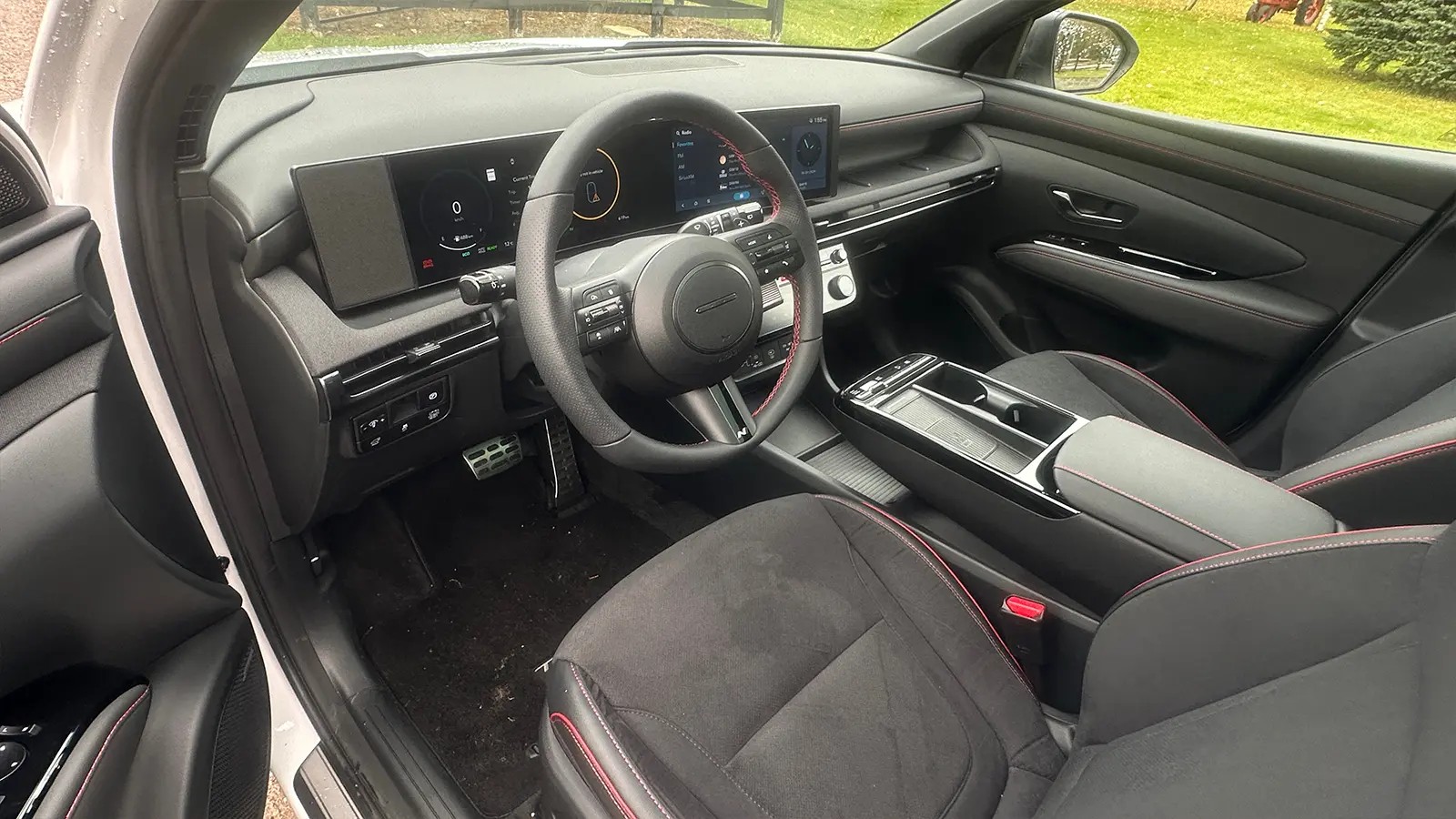 Hyundai Tucson Hybrid front interior
Hyundai Tucson Hybrid front interior
Inside, the Tucson Hybrid N Line embraces a contemporary, all-digital cockpit with dual screens replacing traditional gauges. Red stitching accents throughout the seats, doors, armrest, and steering wheel, along with sporty pedals and an N-branded steering wheel, underscore its performance-oriented character. This sporty ambiance is backed by a potent 1.6-liter turbocharged engine, delivering a combined 231 horsepower and 258 lb-ft of torque on premium fuel (regular fuel is also compatible). Paddle shifters provide manual control over the six-speed automatic transmission, offering a more engaging driving experience compared to the CVTs in the Mazda and Lexus.
While not the most fuel-efficient in its class at 35 mpg combined, the Tucson Hybrid N Line offers a compelling balance of performance and efficiency. Its ample power translates to confident acceleration and highway merging, providing a greater sense of driving enjoyment and safety margin. The Tucson Hybrid powertrain also exhibits a refined character, comparable to, and perhaps even surpassing, the Lexus in smoothness.
Despite its sporty N Line designation, the Tucson Hybrid maintains a comfortable ride, similar to the new 2025 Tucson XRT soft-roading trim. Intriguingly, even in this sporty guise, the Tucson Hybrid N Line includes “Baby Mode,” a driver-selectable feature that softens initial acceleration for passenger comfort, showcasing its family-friendly sensibility. Practicality is another Tucson strong suit, offering more rear-seat room and cargo space than the Mazda CX-50 Hybrid, and significantly more space than the smaller Lexus UX300h.
Overall, the Hyundai Tucson Hybrid N Line emerges as a well-rounded and appealing choice, blending sporty dynamics, family-friendly features, and modern styling into a compelling hybrid SUV package.
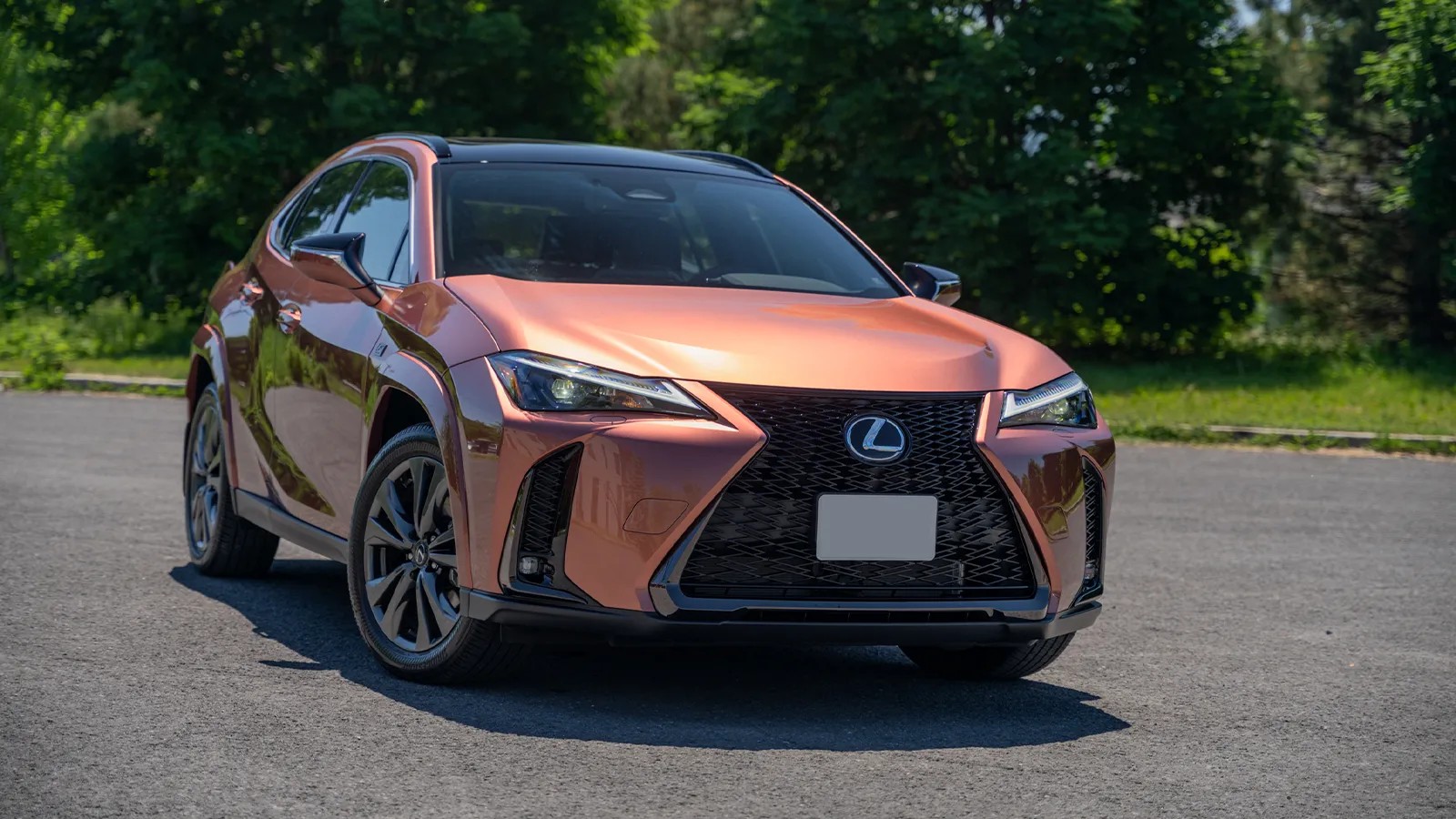 orange Lexus UX300h
orange Lexus UX300h
Lexus UX300h: Compact Luxury Hybrid with Urban Appeal
The Lexus UX300h, formerly known as the UX250h, receives a name change and subtle updates for the 2025 model year. While still positioned as a luxury hybrid SUV, the UX300h feels notably smaller and less powerful than its competitors in this comparison. Its classification as a compact car by fueleconomy.gov, in contrast to the small SUV designation of the Mazda and Hyundai, underscores its more compact dimensions. The UX300h leans towards a subcompact crossover or hatchback in size, making it a unique offering in the luxury hybrid SUV segment.
Its smaller footprint can be advantageous in urban environments, offering enhanced maneuverability and parking ease. The UX300h boasts distinctive Lexus styling, particularly in the F Sport trim tested, which adds sporty visual elements like unique wheels, a black roof, and dark roof rails. However, the oversized Lexus grille might appear disproportionate on the UX’s smaller body to some.
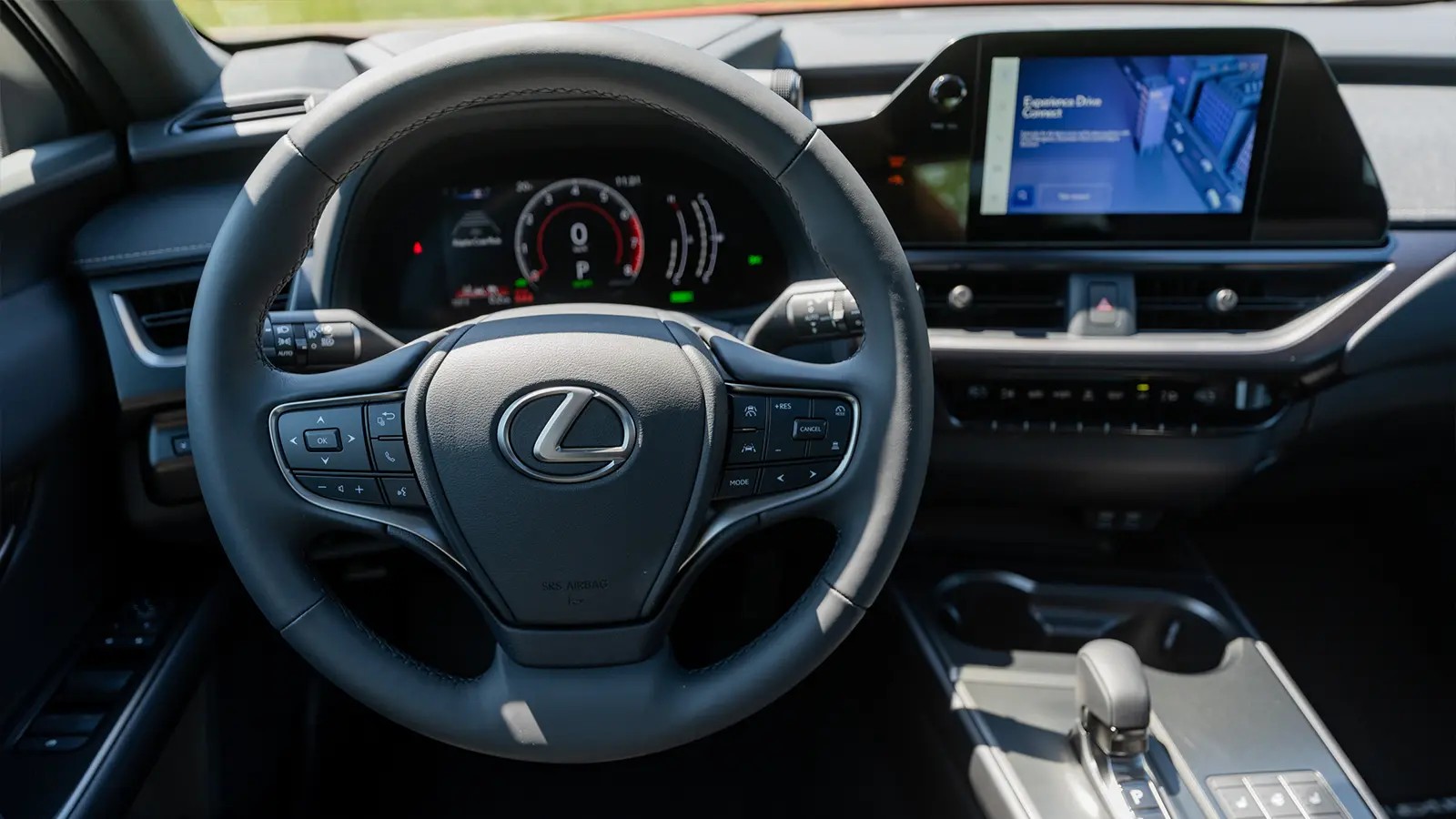 front interior of Lexus UX300h Hybrid
front interior of Lexus UX300h Hybrid
The UX300h’s interior earns high marks for material quality, design, and driver comfort, especially for those under six feet tall. Front-seat spaciousness is comparable to the Mazda and Hyundai, but rear-seat and cargo space are significantly compromised due to its smaller size. The cargo area offers a mere 17.2 cubic feet, less than half the capacity of the Hyundai Tucson Hybrid.
The UX300h’s gauges present a more traditional analog appearance, although a color head-up display is available, a feature not offered on the Mazda or Hyundai in this comparison. A larger 12.3-inch infotainment screen, standard on all but base models, modernizes the interior, but the abundance of physical buttons reflects a design from a less digitally-centric era, which some may find appealing.
Significant powertrain updates include a shift-by-wire CVT system and the adoption of a lithium-ion traction battery, a first for Lexus hybrids, replacing the nickel-metal hydride batteries found in the Mazda and most Toyota hybrids. Power output increases to 196 horsepower, and all-wheel-drive models achieve 42 mpg combined, nearly matching the front-wheel-drive model’s 43 mpg. However, the engine’s noticeable harshness and noise, uncharacteristic of Lexus vehicles, remain a point of concern, potentially amplified by the larger battery which allows for longer periods of engine-off operation.
The Lexus UX300h’s primary appeal lies in its price. With a starting MSRP of $37,515 for the front-drive model and $43,035 for the F Sport AWD version, it offers a relatively accessible entry point into the luxury hybrid SUV segment. While it commands a premium for its upscale interior and Lexus brand cachet, buyers must accept compromises in interior space and engine refinement.
Compact Hybrid Crossovers: The Verdict
Each of these hybrid crossovers presents a unique blend of strengths and weaknesses. However, the Hyundai Tucson Hybrid emerges as the most compelling overall package in this trio. Its combination of practicality, sporty appeal (especially in N Line trim), and modern design, both inside and out, positions it as a forward-thinking choice. The Tucson Hybrid’s versatile nature ensures it remains stylish and relevant as the automotive landscape increasingly embraces electrification, making it our top pick in this comparison of Best Hybrid Suvs.
*All mileage claims are EPA estimated.